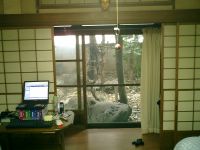Hakuba - Japanese Alps
The mountains seem to come from out of nowhere and burst out of the unnaturally flat farmland. Looking around on the mountain top you can see 3000m peaks knifing up into the sky, and looking down you are surrounded by snow-covered farmland with perfectly straight lines between the different plots of land. The land is so flat it must have been leveled by farmers over the centuries.
Both weekends we stayed at the (Hakuba Alps Backpackers Hostel, which is a pair of nice places near the Hakuba Goryu and Hakuba 47 resorts run by a Kiwi / Japanese husband and wife named Troy and Sakiko. They converted a children's playhouse / nursery school with a windmill into their first hostel, which is now the quiet one. They recently opened a second hostel with a night club in the basement and they hold big parties there every weekend, it seems. They are great people, and have really interesting guests. I highly recommend these places.
The first weekend I spent in Hakuba we arrived a bit late in the afternoon, so Troy helped get us set up with our rental equipment at "Spicy Rentals" (I kid you not), and we hit the slopes. One of the neat things about Japanese resorts is that they give you a chip instead of a ticket. You put it inside your jacket somewhere and then wave it at the automated lift line gate, just like an automatic tollgate in your car. When you're done with it at the end of the day, you put it in a vending machine, and it gives you back your deposit.
We only got a couple of hours in that day, but that was no problem because there was a local festival on the slopes at night. They closed the lifts at about 5, so we headed in for some nice hot ramen to warm us up. Just as we were finishing dinner, they started a Taiko (Japanese drum) performance right outside the window. After the taiko, they reopened the slopes for free night skiing, which was great! They dug holes in the side of the snow wall next to the lift line and put candles inside them, which made the whole wall appear to glow from the inside.
At the end of the night we started to see a line of glowing lights snake it's way down the mountain towards the base lodge. After a little while we could see that it was people skiing with lit torches, but we couldn't see the best part until they got closer. As they approached, we saw a skier carrying a glowing ball leading a Chinese dragon dancing down the slopes! The dragon, which was made up of about 15 individual skiers, made its way down to the waiting crowd, where it proceeded to slowly wrap itself into an intricate knot. The finale was a beautiful fireworks show over the mountainside.
It was at this point that we noticed that the girl next to us was wearing the strangest bunny hat. Instead of big floppy ears, it was a stuffed bunny tied around her head, and it had the saddest look on its face, as if it wished it could be bounding through the meadows rather than spending the rest of it's days tied down to some girls head. I tried to surreptitiously take a photo, but I couldn't get a good shot, whereupon my friend Toru showed me that you don't really need to worry about that kind of thing in Japan. He simply asked her if he could take a photo, and she instantly popped into smiling peace sign mode. Japanese girls are truly gifted at instantaneous photo posing. I believe it may actually be impossible to take a photo of one without her somehow managing to slip a cute little peace sign in.
The snow at Hakuba is amazing, even though it's at a fairly low altitude. Great dry powder and beautiful sunny days. In the trees and ravines between the runs lives a very strange animal called a kamoshika. It looks like a cross between a pig or a bear and a goat or a deer. They have fat round torsos covered in long puffy fur, short deer like legs, and little horns on top. Several of us riding off-piste spotted one or two, and you can even see them from the lifts sometime. We were all a little confused as to what to call them. The most common guess was some kind of bear. Apparently they're actually members of the goat antelope family. I'm not sure if that's goats and antelopes, or goat-antelopes. The latter seems more likely, looking at them. Take a look at some kamoshika pictures and learn more about them.
On the second weekend I went up to Hakuba, the wind was incredibly strong. They had to close the upper half of the mountain several times due to wind conditions. At one point, walking down an ice covered road, the wind was strong enough to push me about 10 feet down the road. Thankfully there were no cars coming. The wind caused the occasional snow whiteout while we were driving around town.
In typical Japanese snowboard trip style, we went to the onsen (Japanese hot spa) to relax both weekends. The wind on the second weekend made the rotenburo (outdoor bath) really spectacular. A good rotenburo is a great way to get in touch with nature. There's nothing like soaking in hot water while looking at a snow covered mountain or a beautiful ravine. On that night, however, Mother Nature was in a fierce mood, which made for a unique experience. The rotenburo was protected by a little bamboo fence which the snow had piled up against, and the wind was whipping tendrils of snow over our heads. Unfortunately, it also whipped all the heat from the water. Most people soaked a towel in hot water and put it on their head so their hair didn't freeze. In the end, I went back inside to enjoy the comforts of a glass-encased view and much hotter water.
One of the reasons why I like living abroad is that it forces you to give up control over parts of your life. In America, if I plan to do something, I can be reasonably sure that it will happen. In a country where you barely speak the language, you can be pretty sure your plans will be forcibly changed on a regular basis. Letting go of control is not something I'm good at, so this can be quite a challenge. Just going with the flow can also lead you to some very interesting experiences that you would have otherwise never come across.
For instance, coming home tired from work, I set my alarm on my Japanese cell phone wrong, and missed my bus to Hakuba in the morning. I ran off to the bus station to see if I could catch a later bus (at about 10 am), but it turns out the next bus was 3:30 in the afternoon, which didn't really work for me. I called up Sakiko, the owner of the hostel, and she told me how to catch a train to Hakuba. I got there late in the afternoon, and snowboarded for an hour using an old board and pair of boots that they had lying around (Sorels style, circa my 1994 snowboard boots). Thankfully the next day they loaned me a pair of Salomon boots they had lying around that just happened to be the same size and model that I have in America. All in all, I spent an extra $80 to get there and missed most of an afternoon of snowboarding, but I got several extra hours of sleep and got to experience riding a train through the middle of a snow field with incredible mountains towering overhead and not a single building in sight, passing remote railway stations on the edges of lakes with only a platform and a tiny roof overhead.
Another thing this trip reminded me about is the importance of attitude. I've always felt that attitude is the single-most important make-or-break aspect of a trip.
One of the best snowboard trips I went to was in Vermont and it rained like crazy all day long. They were giving out trash bags to the few hardy fools who still wanted to go out on the mountain, but basically everyone deserted the mountain. However, we went out with a group of about 20 people, and just had a blast! Since it was raining, it wasn't that cold, and the snow was soft, so we spent the afternoon goofing around, kicking up rooster tails, sliding face first down the mountain, and just general silliness. Most everyone else left the mountain and probably felt that they had wasted their day, but we wound up having an amazing time, and came home with a great story to tell.
I forgot this today, and almost let it ruin my trip. The weather turned very warm (the Japanese snowboarding season really only lasts till the beginning of April), and the snow was wet and heavy. My rental board felt like it had glue on the bottom of it, and I could hardly get enough speed up to try any tricks in the park. I felt like this was the worst snowboarding trip I had ever been on, and I just kept psyching myself out and making myself feel worse and worse. Then, just when I had decided to go to a different part of the mountain, they closed all the upper lifts due to high winds. After taking a bus to the neighboring resort, it turned out that all of their lifts were closed too, and none of my favorite areas were accessible. At that point, I decided to simply let go, and enjoy what was left of my day, and wound up having an amazing run down the mountain on a trail I would normally never take. After goofing around for an hour or two, we caught the last bus back
to the other resort with about 10 seconds to spare, if that, and a potentially catastrophic day was turned into a great day of riding. Even though the good snowboarding only lasted for an hour, it was enough to save the entire day.


